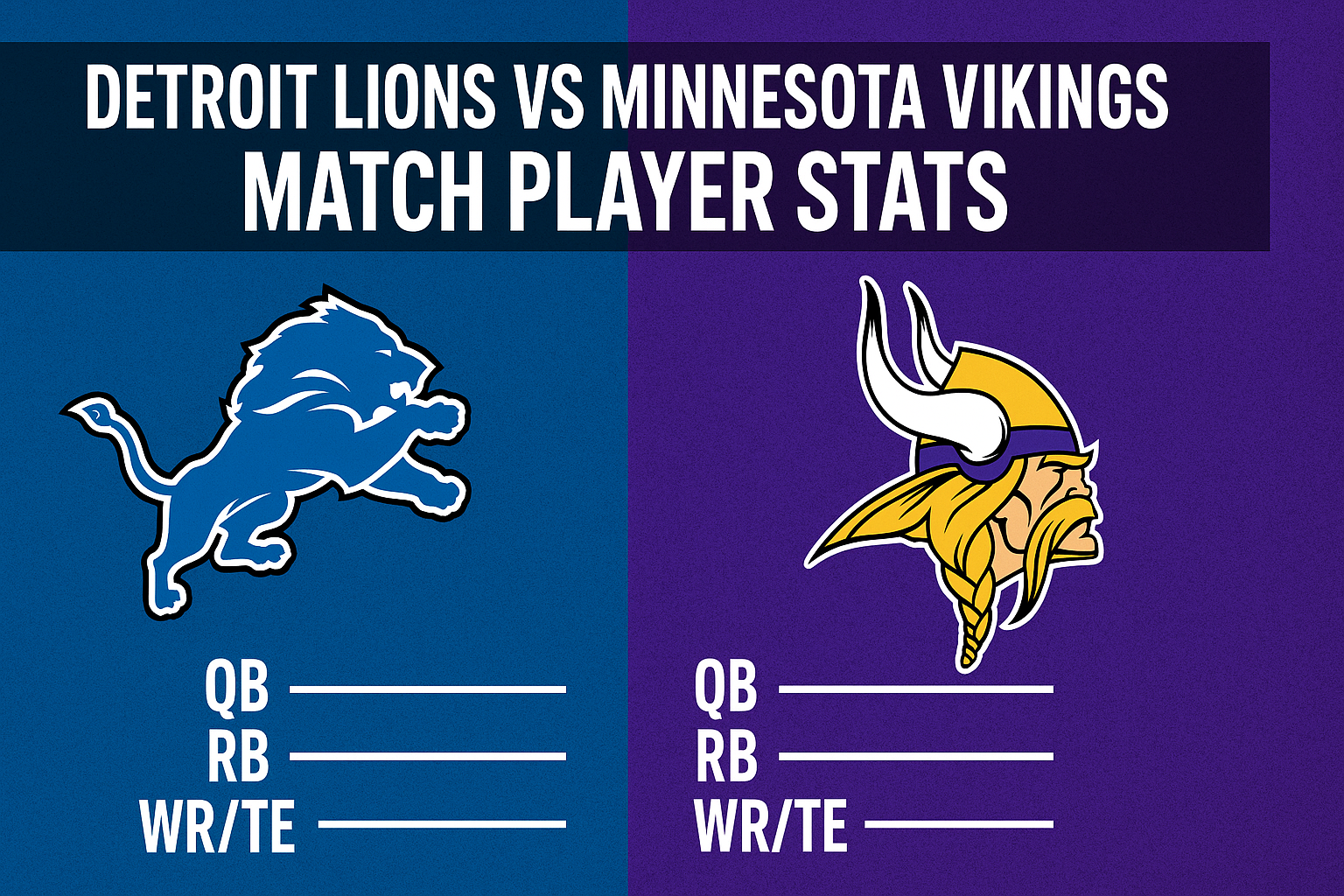When two NFL teams step onto the field, the energy, passion, and strategy unfold in ways that only numbers can capture. The Chicago Bears vs Houston Texans match player stats highlight how each player contributed, who controlled the tempo, and which moments defined the game. While the scoreboard tells the final result, player stats tell the deeper story of effort, execution, and excellence. For both fans and analysts, this matchup offers a wealth of insights into strengths, weaknesses, and game-defining performances.
Historical Rivalry and Context
Though the Chicago Bears and Houston Texans do not share a historic rivalry like some long-standing NFL matchups, their meetings are often intriguing. The Bears, one of the oldest franchises, bring decades of tradition and defensive grit. On the other hand, the Texans, one of the league’s youngest franchises, are eager to cement their reputation through dynamic offenses and aggressive defensive play. Every meeting between these teams becomes a benchmark to measure progress, strategies, and standout player performances.
Quarterback Performances
No football game analysis is complete without diving into quarterback statistics. In Chicago Bears vs Houston Texans match player stats, the quarterbacks often set the tone for their teams.
For the Bears, the quarterback role typically involves balancing short, accurate throws with occasional deep shots. Completion percentage, passing yards, touchdowns, and interceptions reveal whether the QB was efficient or pressured into mistakes. Mobility is also key, as Bears quarterbacks often extend plays or gain yards with their legs.
The Texans’ quarterbacks, by contrast, are known for their ability to stretch the field. Long passes, quick releases, and efficiency in red-zone situations highlight their approach. Stats such as passer rating, average yards per attempt, and accuracy under pressure are vital indicators of performance.
Running Game Analysis
Running backs are crucial in dictating pace and opening up offensive opportunities. The Bears’ style has historically leaned on a physical running game. Stats such as total carries, rushing yards, yards per attempt, and rushing touchdowns are key metrics. For the Bears, ball control and clock management often come from consistent rushing plays.
For the Texans, their backs bring a mix of speed and versatility. Screens, outside runs, and yards after contact are vital to their contribution. The Chicago Bears vs Houston Texans match player stats for running backs often highlight contrasting philosophies—power running versus speed and finesse.
Wide Receivers and Tight Ends
Pass catchers frequently provide the fireworks in games. Wide receivers’ stats such as receptions, total receiving yards, yards after catch, and explosive plays help determine offensive success. For the Bears, receivers are often asked to make clutch catches in contested situations, while Texans’ wideouts thrive on stretching defenses and exploiting mismatches.
Tight ends, meanwhile, offer a dual role: blocking and catching. In close matchups, their contributions in short-yardage situations or red-zone efficiency often tilt the balance. Examining the Chicago Bears vs Houston Texans match player stats of tight ends can reveal hidden heroes who do not always headline the box score but significantly influence the game.
Defensive Front and Linebackers
Defense has always been a Chicago Bears hallmark. Player stats like total tackles, tackles for loss, sacks, and quarterback pressures showcase how the defensive front impacts opposing quarterbacks. In Chicago Bears vs Houston Texans match player stats, these numbers indicate whether the Bears’ pass rush forced mistakes or if the Texans’ offensive line stood tall.
For the Texans, defensive aggression often revolves around disrupting plays early. Stats such as sacks, hurries, and forced fumbles show whether they succeeded in unsettling the Bears’ offensive rhythm. Linebackers also play a pivotal role in stopping the run and covering tight ends, making their tackle numbers and pass deflections important indicators.
Secondary Performances
Turnovers can decide games, and the secondary’s stats often tell that tale. For the Bears, interceptions and passes defended highlight their defensive resilience. Cornerbacks and safeties are tasked with preventing deep shots and limiting yards after catch.
The Texans’ secondary, on the other hand, often emphasizes opportunistic plays. In Chicago Bears vs Houston Texans match player stats, forced turnovers, fumble recoveries, and crucial third-down stops by the secondary usually define their impact. These numbers reveal not only skill but also discipline in high-pressure situations.
Special Teams Contributions
While often overlooked, special teams are a game’s hidden influence. Kick return yards, punt return efficiency, and field goal accuracy can drastically affect momentum. For the Bears, a history of electric returners makes this phase of the game especially exciting.
The Texans’ special teams unit also plays an important role in field position battles. Stats such as net punting average and kick coverage efficiency are vital here. Special teams statistics within the Chicago Bears vs Houston Texans match player stats can show how hidden yardage influences the outcome.
Coaching and Strategy Reflections
Beyond individual performances, player stats reflect coaching strategies. If a team leans heavily on rushing attempts, it shows a game plan focused on control and physicality. If passing stats dominate, the emphasis likely was on exploiting secondary matchups. Defensive stats, especially pressures and turnovers, reflect whether blitz-heavy or coverage-focused schemes were employed.
In Chicago Bears vs Houston Texans match player stats, patterns emerge that highlight coaching philosophies. Did the Bears lean on defense to grind out a win, or did the Texans’ offensive creativity set the pace? These numbers do not just show outcomes—they reveal thought processes and adaptability.
Advanced Statistical Insights
Modern football analysis goes beyond traditional stats. Metrics such as yards after contact, quarterback rating under pressure, defensive efficiency on third down, and red-zone conversion rates provide richer context. For example, a running back with modest total yards but high yards after contact shows individual effort overcoming defensive resistance. A quarterback with fewer passing yards but a high passer rating in the red zone highlights clutch performance.
Examining these advanced insights within Chicago Bears vs Houston Texans match player stats allows for a deeper appreciation of player impact. It distinguishes between empty numbers and meaningful contributions.
Impact on the Season
Every matchup has broader implications. Player stats from Bears vs Texans games influence season narratives, playoff prospects, and even contract discussions. A breakout performance might establish a rising star, while poor numbers could raise questions about depth and consistency. Coaches, general managers, and fans use these stats to project the future direction of their teams.
Fan and Analyst Reactions
The conversation around Chicago Bears vs Houston Texans match player stats does not end when the game does. Fans dissect numbers on social media, comparing performances and debating decisions. Analysts, meanwhile, break down stats on shows, podcasts, and articles, adding context through film study and historical comparisons. These discussions keep the matchup alive long after the final whistle.
Read also: The Complete Guide to Fivebpeol: Meaning, Uses, and Future Potential
Conclusion
The beauty of football lies not only in touchdowns and highlights but also in the numbers that capture every detail. The Chicago Bears vs Houston Texans match player stats offer a complete lens into the game—revealing effort, strategy, and execution. From quarterbacks and running backs to defensive playmakers and special teams contributors, every stat tells part of the story. For fans, analysts, and even the teams themselves, these statistics form the foundation of understanding what truly happened on the field and what it means for the future.



